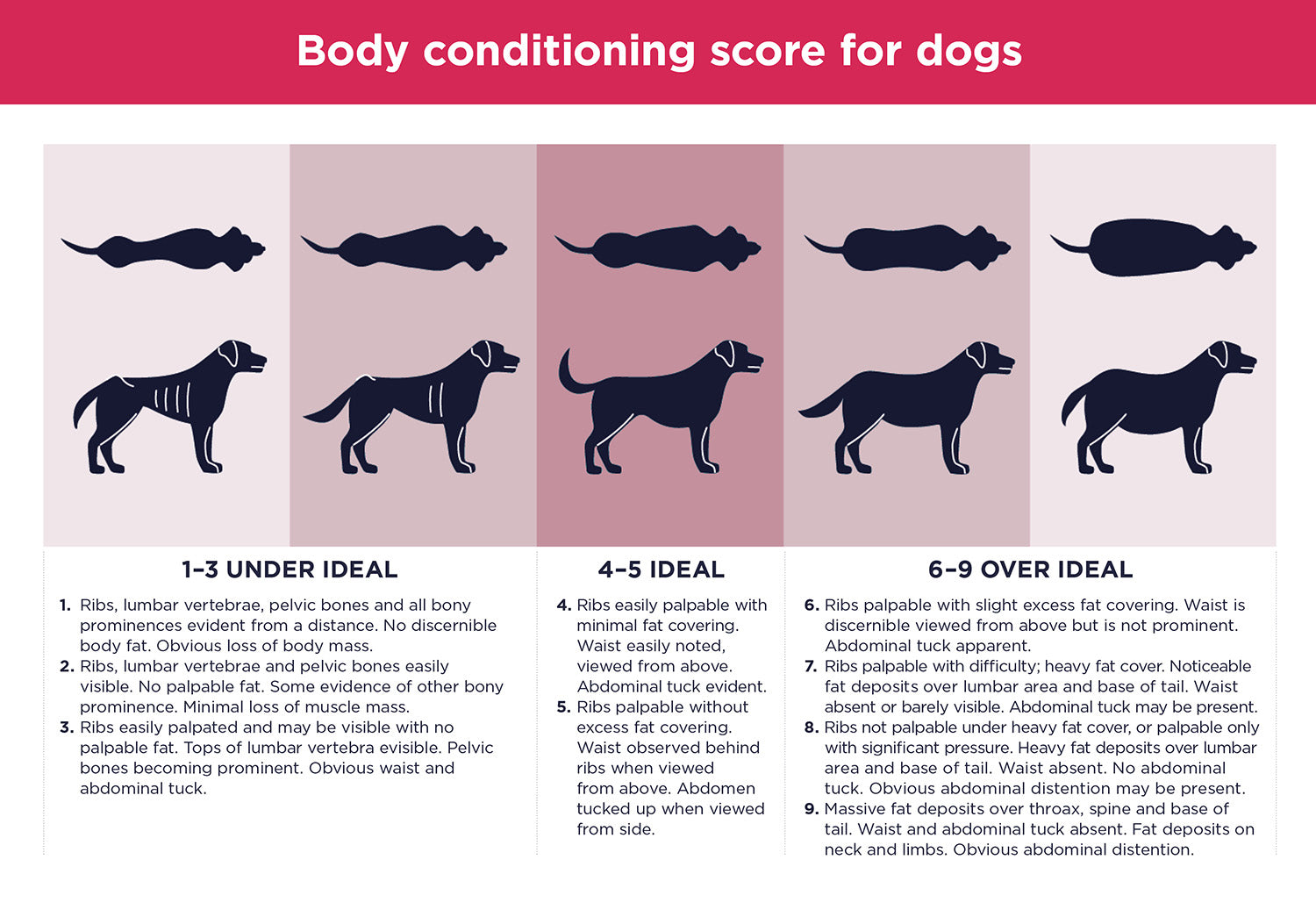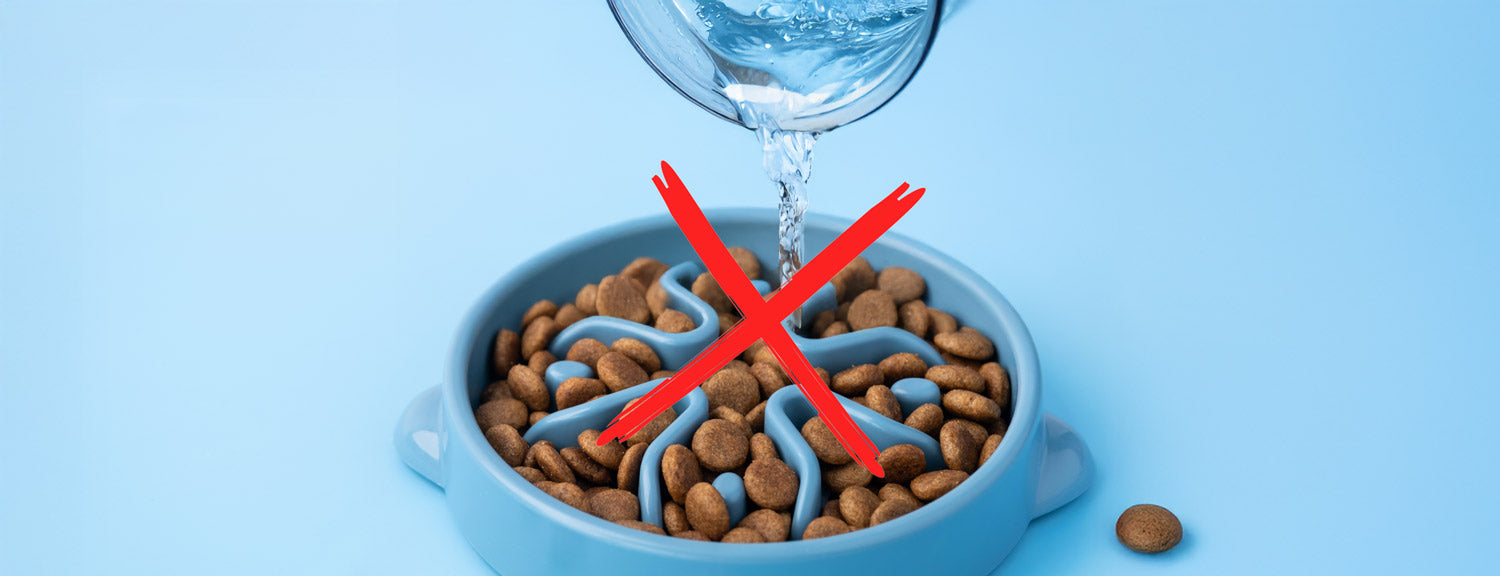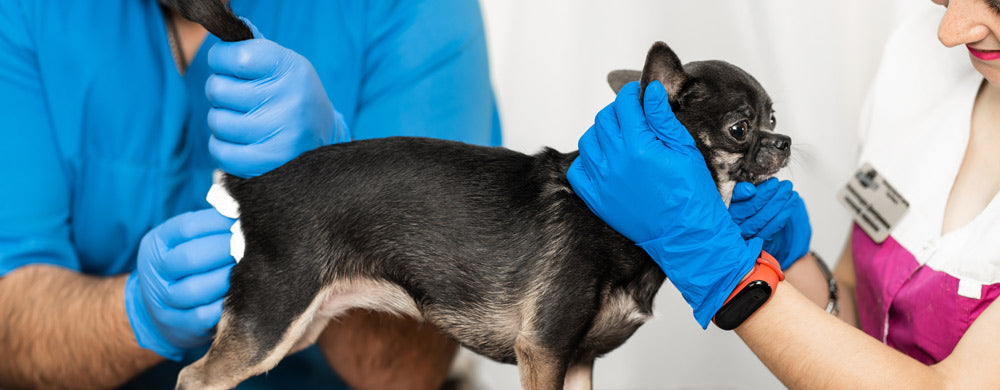Your basket is empty

How to Prevent and Address Dog Obesity: A Comprehensive Guide
July 05, 2023 8 min read
In recent years, dog obesity has become a significant concern among pet owners across the UK. The recent PDSA Animal Wellbeing Report indicated that up to 65% of dogs in the UK are overweight or obese. This worrying trend can lead to various health issues, from heart disease and diabetes to joint problems and a shortened lifespan. Understanding the causes, prevention methods, and treatments for dog obesity is crucial for all dog owners wishing to provide their pets with the best possible care.
Understanding Dog Obesity
Dog obesity is defined as an excess of body fat that is sufficient to compromise health. It is not a matter of aesthetics but rather a severe health issue. Obesity in dogs is a medical condition that has been clinically proven to affect the quality and length of a dog's life. When a dog carries excess weight, the body becomes overloaded. The joints strain under pressure, and vital organs must work harder than they should. The ability of the dog’s body to function properly is compromised, leading to a diminished quality of life and potential health risks.
***
Causes of Dog Obesity
Dog obesity primarily occurs due to an imbalance between energy intake and expenditure. In other words, weight gain is inevitable if a dog consumes more calories than it burns off. Certain factors may predispose a dog to obesity, including breed (some breeds, like Labradors and Beagles, are more prone), age (older dogs are often less active), and neutering. However, the two key causes in most cases are overfeeding (especially foods high in sugar and fat) and a lack of physical activity.
***
The Dangers of Dog Obesity
The health risks associated with dog obesity are severe. Overweight dogs are at a higher risk of developing many health problems, including diabetes, respiratory diseases, heart diseases, and even certain types of cancer. Moreover, excessive weight puts undue strain on the skeletal system, exacerbating conditions like arthritis and hip dysplasia. Obesity can also lead to a reduced tolerance for heat and exercise, a lower immune function, and, potentially, a shorter lifespan.
***
Recognising Obesity in Your Dog
Understanding, if your dog is overweight isn't always straightforward. Sometimes, a gradual increase in weight can be challenging to notice. But a few signs indicate your dog may be carrying excess weight.
These include:
- difficulty in feeling the ribs, spine, or waistline
- a lack of discernible waist when viewed from above
- excess fat around the tail base
- abdominal sagging.
Regular body condition assessments can be an invaluable tool for monitoring your dog's weight over time.

***
The Knuckle Test
@dogsloungeuk Ever heard of the 'knuckle test' for your dog's weight? 🤔 Curious to know if your furry friend is at a healthy weight? 💪 Find out now! #DogWeightCheck #HealthyDog #KnuckleTest #PetHealthTips #doghealth #doghealthtips #obesity #obesedog #canineobesity ♬ original sound - dogsloungeuk
***
Preventing Dog Obesity
The key to preventing dog obesity lies in maintaining a healthy balance of nutrition and exercise. An appropriate diet is paramount – it should be balanced, calorie-controlled, and portioned correctly for your dog's breed, age, and size. It's also crucial to avoid over-reliance on treats, especially human food, which can quickly add up in terms of calories. Regular exercise, suitable for your dog’s breed and age, should be incorporated into their daily routine.
The first step to determine calorie requirements is to calculate the dog’s resting energy requirements (RER). The RER is the amount of calories needed for basic biological functions such as digestion, heart rate, etc. Please note, this caloric amount does not factor in the activity level.
A scientific calculator (or equivalent mobile phone app) will be helpful to accomplish the following equation. Enter the dog’s bodyweight in kilograms, press the exponent key, then enter 0.75. Then multiply the result by 70. See example below.
EXAMPLE
Dog's weight - 25kg
RER calculation
70 x (25)^0.75 = 782 RER
70 x (Body Weight in kg) ^ 0.75 = Resting Energy Requirements
Once you know your dog's RER, you can then calculate its daily energy requirements (DER). The DER is the total calories needed to sustain basic biological functions including daily activity. Calculation amounts will vary in relation to the dog’s daily activity and individual metabolism.
| ACTIVITY LEVEL |
ENERGY NEEDS
|
| Weight loss |
1
|
| Inactive & obese prone |
1.2
|
| Inactive |
1.4
|
| Neutered & low activity |
1.6
|
| Intact & low activity |
1.8
|
| Young adult & average activity |
2
|
| Above average activity (3 hours daily) |
3
|
To calculate your dog's DER, multiply their RER by the energy needs multiplier.
EXAMPLE
Dog's weight - 25kg
RER - 782
Energy needs - inactive (1.4)
DER calculation
782 x 1.4 = 1094.8kcal Daily Energy Requirements (DER)
*Note: The DER calculations are to be taken as a guideline and should be adjusted according to the dog’s individual requirements. Since metabolism varies among individuals, the energy needs multiplier needs to be higher for high-energy or underweight individuals and lower for low-energy or overweight individuals.
***
Addressing Dog Obesity
Tackling dog obesity requires a multi-faceted approach. Firstly, consult with your vet to ensure there are no underlying health conditions contributing to the weight gain. A tailored weight loss plan, comprising a low-calorie diet and structured exercise regimen, can then be developed. Remember, weight loss should be gradual to be safe and sustainable. Regular weigh-ins will help track progress and adjust the plan as necessary.
***
Dietary Changes for Dog Obesity
When it comes to addressing canine obesity, diet is a pivotal factor. While exercise aids in burning calories, the type and amount of food you feed your dog can significantly impact their weight. Here's how you can make necessary dietary changes:
Mind the Portions: Overfeeding is one of the leading causes of obesity. Always refer to the feeding guidelines on pet food packages, but remember these are often overstated and may not consider your dog's individual needs. Consult your vet for an accurate daily calorie count for your dog.
Choose Quality Food: Not all dog food is created equal. Opt for high-quality, nutritionally balanced dog food that is rich in lean proteins and has an appropriate balance of carbohydrates and fats. Avoid foods with excessive fillers, added sugars, and artificial ingredients.
Consider Diet Dog Food: Some brands offer 'light' or diet versions of their regular dog food. These products have fewer calories and lower fat content but still provide essential nutrients. They can be a useful tool for weight management when used correctly.
Include More Protein: High-quality proteins can help maintain lean muscle mass during weight loss. They also aid in satiety, helping your dog feel full and satisfied for longer, thereby reducing the urge to overeat.
Limit Treats: Treats are often calorie-dense and can quickly add up if not controlled. As a general rule, treats should not make up more than 10% of your dog's daily calorie intake. Consider low-calorie or homemade alternatives like carrots or cucumber slices.
Measure Meals: Using a measuring cup or scale can help ensure you're not overfeeding your dog. Estimating portion sizes can easily lead to inadvertent overfeeding.
Frequency of Feeding: Feeding smaller meals more frequently can help manage hunger and maintain stable blood sugar levels, reducing the likelihood of overeating.
Fresh Water: Always ensure your dog has access to fresh, clean water. Sometimes, dogs may mistake thirst for hunger.
Supplements: Certain dietary supplements may assist in weight management.
However, always consult your vet before adding any supplements to your dog's diet. Remember, drastic dietary changes can upset your dog's stomach, so any changes should be made gradually over a week or two. Additionally, all dietary changes should be discussed with and monitored by your vet to ensure your dog is getting adequate nutrition while losing weight.
***
Exercise for Dog Obesity
Exercise plays a critical role in addressing dog obesity. It not only helps burn off excess calories, but it also strengthens muscles, improves heart health, aids digestion, and boosts mental wellbeing.
The type and amount of exercise required will depend on your dog's current health status, breed, and age. Dogs with a significant amount of weight to lose, or those with pre-existing joint issues, should start with low-impact activities.
Walking: Walking is a low-impact exercise that suits dogs of all fitness levels. Start with gentle, shorter walks and gradually increase the duration and intensity as your dog's stamina and physical condition improve. If your dog enjoys walking, consider introducing slight variations like uphill walks for an extra challenge.
Swimming: Swimming is an excellent exercise for overweight dogs, particularly those with joint issues, as it provides resistance to burn calories without adding stress to the joints. Always ensure your dog is comfortable and safe around water before introducing them to swimming.
Fetch Games: Games like fetch can provide both mental and physical stimulation. They encourage short bursts of running, which can contribute to weight loss. Ensure the fetch sessions are conducted on soft ground to protect your dog's joints. Please note: fetch is considered a high-impact exercise and may not be suitable for all dogs.
Indoor Exercises: On days when outdoor activities are not feasible, indoor exercises can keep your dog active. Create a mini obstacle course, play hide and seek with toys or practice new tricks — each activity will keep your dog moving and engaged.
Interactive Toys: Toys that make your dog work for treats are a great way to stimulate your dog both mentally and physically. These can include puzzle feeders or treat-dispensing toys, which encourage movement and problem-solving. Use your dog's daily food allowance instead of adding extra treats to their diet. Remember that any new exercise regimen should be introduced gradually, giving your dog's body time to adjust to the new levels of physical exertion. It's also crucial to consider the weather conditions when planning your dog's exercise, as both extreme heat and cold can be dangerous for dogs, particularly for those who are overweight.
Monitoring your dog during exercise is essential. Watch for signs of overexertion such as excessive panting, difficulty breathing, or a reluctance to move. Always consult with a vet before starting any new exercise programme, especially if your dog is significantly overweight or has other health conditions.
***
The Role of the Vet in Addressing Dog Obesity
Veterinary professionals play a vital role in preventing, diagnosing, and managing dog obesity. They have the knowledge and resources to provide customised care, ensuring that your dog’s weight management plan is both safe and effective.
Early Diagnosis: Vets can identify signs of obesity during regular check-ups. By routinely monitoring your dog's weight and body condition, they can spot any troubling weight gain trends early, before the issue becomes severe. They may use a tool known as the Body Condition Score to evaluate your dog's physique.
Dietary Guidance: Based on your dog’s breed, age, health status, and lifestyle, vets can provide personalised dietary recommendations. They can advise on the type of diet, portion sizes, and feeding frequency to aid in weight loss without compromising nutritional balance.
Exercise Recommendations: A vet can guide you on the type and amount of exercise suitable for your dog, taking into account their current physical condition and any pre-existing health issues. This is particularly important for dogs with joint problems, where certain types of exercise may be harmful.
Health Screenings: Obesity can often be a symptom of underlying health issues, such as hypothyroidism or Cushing’s disease. A vet can perform diagnostic tests to rule out these conditions.
Weight Loss Monitoring: Regular vet visits are crucial to monitor your dog's progress. If your dog isn’t losing weight or is losing weight too quickly, the vet can adjust the weight management plan accordingly.
Prescription Diets: In some cases, vets may recommend prescription diet foods specifically designed for weight loss in dogs. These diets are often lower in calories but still nutritionally complete.
Post-Obesity Management: Once your dog has reached their target weight, the vet will advise on maintaining this weight, as dogs can easily regain weight if not properly managed.
***
The Importance of Addressing Dog Obesity
Dog obesity is a serious issue, but with knowledge, dedication, and the right support, it’s one that can be successfully addressed. Remember, the goal is not just to reduce your dog’s weight, but to improve their overall health and happiness. By understanding the risks and taking steps to prevent and address obesity, you can help ensure your furry friend enjoys a long, active, and healthy life.
Also in Pet Advice

Should You Add Water to Your Dog’s Kibble? Here’s What the Science Says
August 14, 2025 7 min read
Should you add water to your dog’s kibble? Discover the science-backed pros, cons, and better alternatives like bone broth and fresh food to improve hydration, digestion, and overall canine health...

DIY Frozen Dog Treats Your Pup Will Love
June 27, 2025 4 min read
Summer heat can be dangerous for dogs, making hydration more important than ever. Learn how to spot signs of dehydration, boost your pup’s water intake, and create fun, frozen recipes to keep them happy and healthy all season long.

Why Is My Dog Scooting? Common Causes and How Diet Can Help
May 09, 2025 4 min read
If your dog is scooting or smells fishy, it could be due to blocked or irritated anal glands. Learn what causes blocked anal glands, which dogs are most at risk, and how simple dietary changes—like adding fibre and anti-inflammatory nutrients—can help prevent recurring problems.
Search our shop
In this article
- Understanding Dog Obesity
- Causes of Dog Obesity
- The Dangers of Dog Obesity
- Recognising Obesity in Your Dog
- The Knuckle Test
- Preventing Dog Obesity
- Addressing Dog Obesity
- Dietary Changes for Dog Obesity
- Exercise for Dog Obesity
- The Role of the Vet in Addressing Dog Obesity
- The Importance of Addressing Dog Obesity
